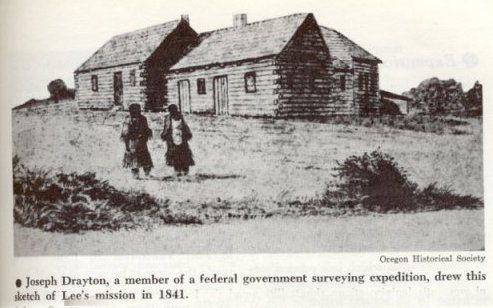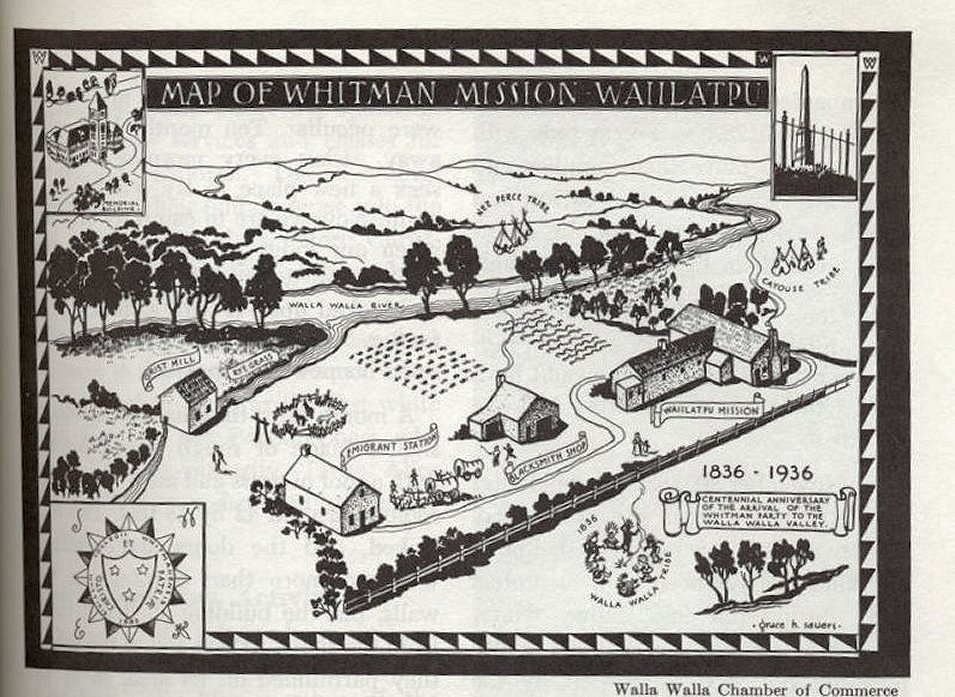 METHODIST MISSION:
METHODIST MISSION:

Compiled by Stephenie Flora
On April 28, 1834, Jason and Daniel Lee and two lay assistants,
Cyrus Shepard and Philip Edwards, left St. Louis for Oregon
in the company of Captain Nathaniel Wyeth and his adventurers and
trappers. Upon their arrival at Fort Vancouver September 15, 1834 they
commenced choosing a site for the mission. In October 1834 the first
mission in the Oregon country was established on the Willamette
River north of the the present day city of Keizer.
In 1837, in response to a request for additional help, another
group of missionaries were sent to join Lee. By March of 1838,
it was determined to establish a second mission at the Dalles. It would
be called
Wascopam
. Meanwhile, Lee, still in need of more
assistance, returned east to plead his case. Shortly after his
departure his wife and new born baby died and were buried
in a single grave at the mission.
A messenger was sent to advise him of his loss.
Lee continued on to the east and by the following spring he
had raised contributions totaling about $100,000, had recruited
51 people to join forces with those already on the Willamette,
and had met and married Lucy Thompson.
Upon his return to the mission with the reinforcements, it was
decided to move the mission to a more healthful location in what
is now downtown Salem. The ensuing years were hard ones for Lee.
His second wife died after only two years and the differing
philosophies with his laymen created tensions that finally resulted in his
recall. He returned to Stanstead, Canada, in poor health, and died there
shortly before his 42nd birthday in 1845. It wasn't until 1906 that he
was reinterred in the Lee Mission Cemetery in Salem beside his two
wives, baby son, and daughter.
 PRESBYTERIAN MISSION:
PRESBYTERIAN MISSION:
 While Jason Lee was struggling to keep the Willamette Mission
going, Dr. Marcus Whitman was investigating the possibility of
establishing a mission. Whitman, a country doctor from New
York State, and a very devout person, had previously been
rejected for missionary work due to his poor health. Early in 1835,
however, Whitman succeeded in getting an appointment from the American
Board of Commissioners for Foreign Missions to establish a mission in
the Oregon country.
While Jason Lee was struggling to keep the Willamette Mission
going, Dr. Marcus Whitman was investigating the possibility of
establishing a mission. Whitman, a country doctor from New
York State, and a very devout person, had previously been
rejected for missionary work due to his poor health. Early in 1835,
however, Whitman succeeded in getting an appointment from the American
Board of Commissioners for Foreign Missions to establish a mission in
the Oregon country.
In 1835 Whitman made a preliminary trip with Samuel Parker, in
the company of a fur trading expedition,
to talk to the Indians. After returning from Green River in
1835, (Parker remained in the Oregon country)
Whitman spent the winter of 1835-36 raising funds, buying
supplies and recruiting a party.
The party included Whitman, his bride Narcissa Prentiss Whitman,
Rev. Henry Spalding and his wife Eliza, as well as several hired
hands and Indian boys. William Gray, a bachelor, served as scout and
general manager for the expedition. Narcissa and Eliza became an
important part of history as the first white women to make the overland
trip to the West.
On September 12, 1836 the party reached Fort Vancouver where the
ladies remained while their husbands scouted the region for an
appropriate site for the mission. In the end it was decided to establish two
missions. Whitman established his mission near the Cayuse at
Waiilatpu and Spalding established his near the Nez Perce at Lapwai,
about 125 miles east of Waiilatpu.
William Gray left almost immediately for the east to seek
reinforcements
for the missions. He returned in 1838 with his bride Mary and a
party of
seven including Rev. and Mrs. Cushing Eells, Rev. and Mrs.
Elkanah Walker,
Rev. and Mrs. A.B. Smith and Cornelius Rogers, a bachelor. They
arrived
at the mission at the end of August 1838.
There was much dissension amongst the party, as the couples did
not get
along well with each other and indications were that the Grays
were not
liked by any of the others. Spalding and Whitman frequently
quarreled and
nearly every member of the group wrote to the Mission Board at
one time or
another about the conduct of his associates. In frustration over
the lack
of harmony, threatened closure of the mission. By the time news
of the
Board's decision reached Waiilatpu, the situation had changed.
The Smiths,
Grays, and Cornelius Rogers had resigned and left the Oregon
country. The
Spaldings, Eellses, Walkers and Whitmans had reconciled their
differences.
Whitman returned to the east in the winter of 1842 to warn of the
possibility
of losing the Northwest to Great Britain and to publicize the
opportunities
available in the Oregon Country. His journey was instrumental in
encouraging
colonization of the west. In 1843, on his return journey he
accompanied a
wagon train of settlers. As the preceeding years brought more
trains and
settlers, disease began to decimate the tribes. In 1847, after
rising
tensions with the Cayuse Indians, Whitman and Narcissa
were killed in a massacre that left many dead and the remainder
held captive
until their release was negotiated by Peter Skene Ogden.
For Additional Information:
Whitman Massacre
including a list of the participants.
Whitman Mission National Historic Site
 CATHOLIC MISSIONS:
CATHOLIC MISSIONS:
After Jason Lee set up his mission in 1834, French Catholic
residents of nearby French Prairie requested of Dr. McLoughlin
that a Catholic priest be
sent to them so that they could attend their own church.
The first two Catholic missionaries in the Pacific Northwest were Father Francois Blanchet and his assistant Father Modeste Demers. St. Francis, the first Catholic mission, was established on the Cowlitz River in 1838, under Father Demer's charge. In 1840, the St. Paul Mission was established at French Prairie, under the direction of Father Blanchet. Eventually both priests were elevated to the rank of Bishop. Father Blanchet became Bishop of Oregon and Father Demers became Bishop of Vancouver Island. The Sisters of Providence arrived in 1856 to assist.
![]()
My name is Stephenie Flora. Thanks for stopping
by. Return to [
Home Page
] All [
Comments and Inquiries
] are welcome.